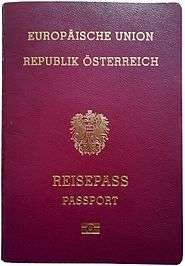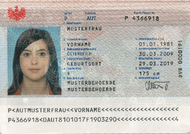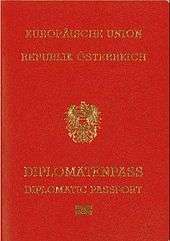Austrian passport

| Austrian passport | |
|---|---|
 The data page of an Austrian biometric passport (2009) | |
| Date first issued | June 16, 2006 |
| Issued by |
|
| Type of document | Passport |
| Purpose | Identification |
| Eligibility requirements | Austrian citizenship |
| Expiration | 2 years after issuance for children up to the age of 1; 5 years for children aged 2–11; 10 years for citizens aged 12 and older |
| Cost | €75,90[1] |
Austrian passports are issued to citizens of Austria to facilitate international travel. Every Austrian citizen is also a citizen of the European Union. The passport, along with the national identity card allows for free rights of movement and residence in any of the states of the European Economic Area and Switzerland.
Physical appearance

Austrian passports are the same burgundy colour as other European passports, and with the Austrian Coat of arms emblazoned in the centre of the front cover. The words "EUROPÄISCHE UNION" (English:European Union) and "REPUBLIK ÖSTERREICH" (English: Republic of Austria) are inscribed above the coat of arms and the word "REISEPASS" (English: Passport) is inscribed below. Austrian passports have the standard biometric symbol at the bottom and use the standard EU design. Each page of the passport shows the coat of arms of a different Austrian province in the background.
Different spellings of the same name within the same document
German names containing umlauts (ä, ö, ü) and/or ß are spelled in the correct way in the non-machine-readable zone of the passport, but with simple vowel + E and/or SS in the machine-readable zone, e.g. Müller becomes MUELLER, Groß becomes GROSS, and Gößmann becomes GOESSMANN.
The transcription mentioned above is generally used for airplane tickets etc., but sometimes (like in US visas) also simple vowels are used (MULLER, GOSSMANN). The three possible spelling variants of the same name (e.g. Müller / Mueller / Muller) in different documents sometimes lead to confusion, and the use of two different spellings within the same document (like in the passport) may give people who are unfamiliar with the German orthography the impression that the document is a forgery.
The Austrian passport can (but does not always) contain a note in German, English, and French that AE / OE/ UE / SS are the common transcriptions for Ä / Ö / Ü / ß.
Visa free travel
Visa requirements for Austrian citizens are administrative entry restrictions by the authorities of other states placed on citizens of Austria. In 2016, Austrian citizens had visa-free or visa on arrival access to 173 countries and territories, ranking the Austrian passport 5th in the world.[2]
Holding a second passport
Austria allows its citizens to hold a second Austrian passport to circumvent certain travel restrictions (e.g. some Arab countries do not allow entry with Israeli passport stamps, e.g. Bahrain, Iraqi Kurdistan [not the rest of Iraq], Oman, Mauritania, Tunisia, and the United Arab Emirates).
History
Before Austria became a member of the European Union, passports had a dark green cover.
